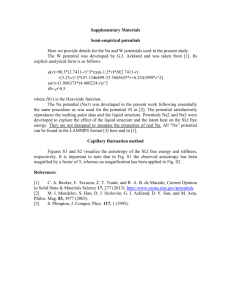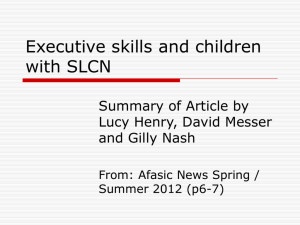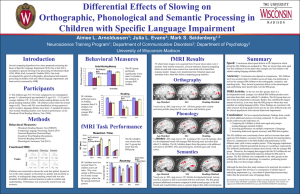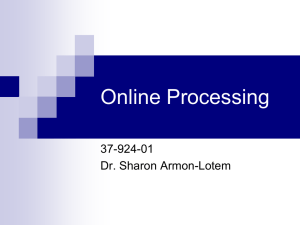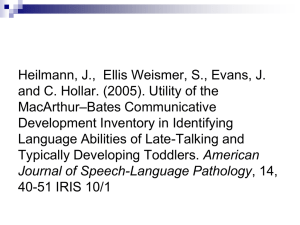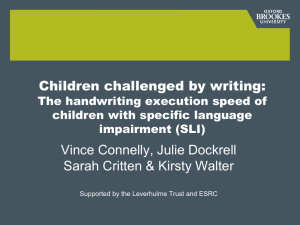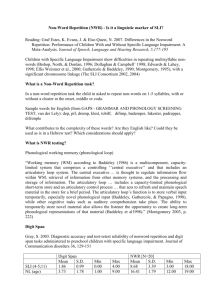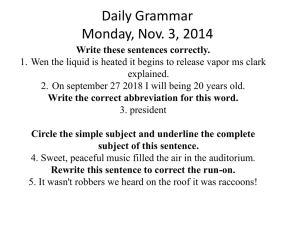Oglivie Final Report
advertisement
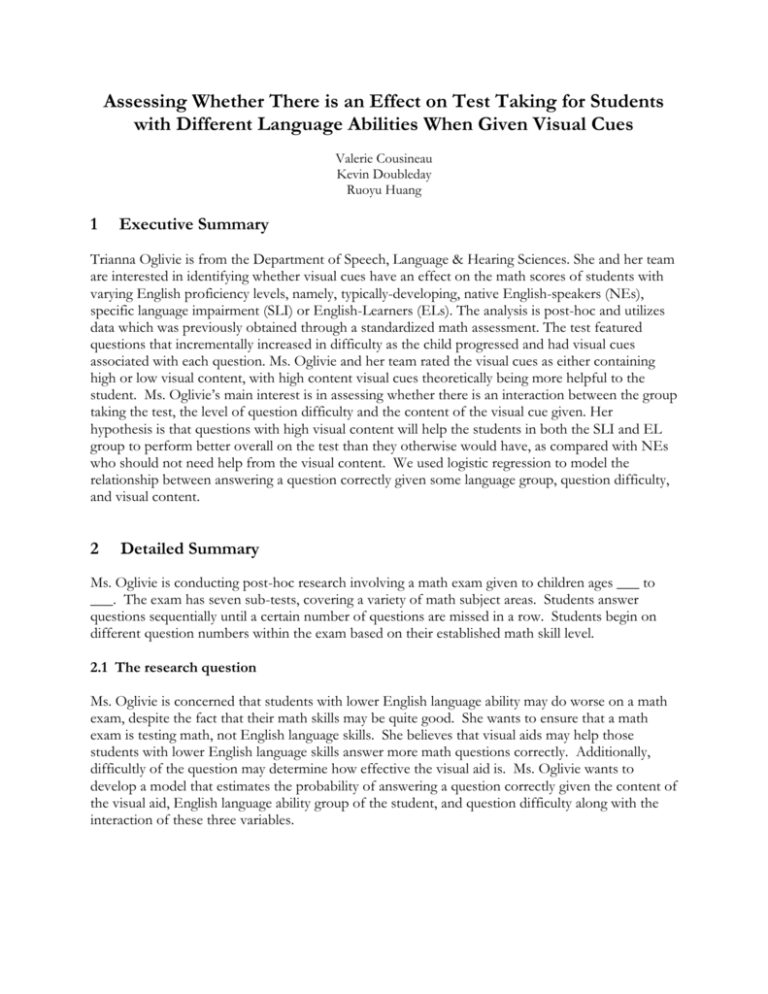
Assessing Whether There is an Effect on Test Taking for Students with Different Language Abilities When Given Visual Cues Valerie Cousineau Kevin Doubleday Ruoyu Huang 1 Executive Summary Trianna Oglivie is from the Department of Speech, Language & Hearing Sciences. She and her team are interested in identifying whether visual cues have an effect on the math scores of students with varying English proficiency levels, namely, typically-developing, native English-speakers (NEs), specific language impairment (SLI) or English-Learners (ELs). The analysis is post-hoc and utilizes data which was previously obtained through a standardized math assessment. The test featured questions that incrementally increased in difficulty as the child progressed and had visual cues associated with each question. Ms. Oglivie and her team rated the visual cues as either containing high or low visual content, with high content visual cues theoretically being more helpful to the student. Ms. Oglivie’s main interest is in assessing whether there is an interaction between the group taking the test, the level of question difficulty and the content of the visual cue given. Her hypothesis is that questions with high visual content will help the students in both the SLI and EL group to perform better overall on the test than they otherwise would have, as compared with NEs who should not need help from the visual content. We used logistic regression to model the relationship between answering a question correctly given some language group, question difficulty, and visual content. 2 Detailed Summary Ms. Oglivie is conducting post-hoc research involving a math exam given to children ages ___ to ___. The exam has seven sub-tests, covering a variety of math subject areas. Students answer questions sequentially until a certain number of questions are missed in a row. Students begin on different question numbers within the exam based on their established math skill level. 2.1 The research question Ms. Oglivie is concerned that students with lower English language ability may do worse on a math exam, despite the fact that their math skills may be quite good. She wants to ensure that a math exam is testing math, not English language skills. She believes that visual aids may help those students with lower English language skills answer more math questions correctly. Additionally, difficultly of the question may determine how effective the visual aid is. Ms. Oglivie wants to develop a model that estimates the probability of answering a question correctly given the content of the visual aid, English language ability group of the student, and question difficulty along with the interaction of these three variables. 2.2 Variable scales Our prediction model includes three variables, namely, visual aid content, and English language group, and question difficulty. Visual aid content is rated as “Low” or “High” based on a visual assessment. English language group has three levels, typically developing native English speaker (NE), specific language impairment (SLI), and English-learners (EL). A substantial proportion of the questions at the beginning and end of the exam were not answered so selection of questions to include in the analysis was done by pairing question of similar difficulty, but with opposite visual content designations, on “Low” and one “High”. Question difficulty was classified as “Easy” or “Hard” where the easy questions are located toward the beginning of the exam and a substantial proportion of students provided an answer. A similar procedure was used to classify the hard questions, but selection was done toward the end of the exam. Questions from the geometry and numeration portions of the exam were included in this analysis. 2.3 Statistical analysis The outcome of interest is the probability of answering a question correctly, hence we will use logistic regression to estimate these probabilities. Terms for visual content, question difficulty, and language group along with their pairwise interactions and three way interaction will be included in the model. 3 Results 3.1 Logistic model The estimates from the logistic model are found in Table 1. Table 1. Estimates from the logistic model for answer a question correct. Parameter Estimate 95% Confidence Log(odds correct) Interval Intercept 1.20 -Question Difficulty -2.98 (-3.88, -2.08) (Ref=Easy) Visual Aid (Ref=Low) -0.39 (-1.13, 0.36) Language Group NE 1.27 (0.31, 2.22) (Ref=Group SLI) Language Group EL -0.02 (-0.83, 0.80) (Ref=Group EL) Difficulty*Visual 1.67 (0.49, 2.85) Difficulty*Group NE -0.62 (-1.88, 0.65) Difficulty*Group EL 0.15 (-1.02, 1.33) Visual*Group NE -0.15 (-1.40, 1.11) Visual*Group EL 0.84 (-0.28, 1.96) Difficulty*Visual*Group NE -0.01 (-1.72, 1.70) Difficulty*Visual*Group EL -0.98 (-2.62, 0.65) p-value -<0.001 0.31 0.01 0.97 0.01 0.34 0.80 0.82 0.14 0.99 0.24 We see that the estimates for question difficulty, language group NE, and the interaction between difficulty and visual aid are significant (p < 0.05). Positive estimates indicate an increase in the probability of answering a question correctly for the given characteristic, relative to the reference category. For instance, the question difficulty estimate of -2.98 indicates that for those in the same language group working on questions with similar visual content presented, there is a decreased probability of answering the question correctly if the question is difficult versus if the question is easy. The estimate for the question difficulty, visual aid interaction of 1.67 indicates that for difficult questions, the probability of answering correctly increases with the high content visual aid versus low content. Additionally, since this interaction is statistically significant, the visual aid content modifies the effect of the question difficulty on chances of answering correctly. In other words, the relationship between answering a question correctly and visual content provided is different for easy and hard questions. See Table 2 for examples. 3.2 Converting log(odds) to probability Odds is defined as the probability of an event divided by one minus the probability of the event: 𝑂𝑑𝑑𝑠(𝐸𝑣𝑒𝑛𝑡 𝐴) = 𝑃(𝐸𝑣𝑒𝑛𝑡 𝐴) 1 − 𝑃(𝐸𝑣𝑒𝑛𝑡 𝐴) We can solve for the probability of the event and find: 𝑃(𝐸𝑣𝑒𝑛𝑡 𝐴) = 𝑜𝑑𝑑𝑠(𝐸𝑣𝑒𝑛𝑡 𝐴) 1 + 𝑜𝑑𝑑𝑠(𝐸𝑣𝑒𝑛𝑡 𝐴) The logistic model estimates the log(odds of an event) so we must exponentiate the estimates before solving for the probability. Table 2 contains the probabilities of all combinations of question difficulty, visual aid content, and English language group. Table 2. Probabilities of answering question correct. Visual Question Language Estimated Probability Content Difficulty Group of Correct Answer High Easy SLI 0.83 High Easy NE 0.93 High Easy EL 0.65 Low Easy SLI 0.81 Low Easy NE 0.90 Low Easy EL 0.78 High Hard SLI 0.33 High Hard NE 0.44 High Hard EL 0.40 Low Hard SLI 0.20 Low Hard NE 0.28 Low Hard EL 0.18 Of note is that high visual content helped students in the SLI and NE language groups answer easy questions correctly, but only by a small margin (SLI: 0.83 vs. 0.81; NE: 0.93 vs. 0.90). All three language groups were helped by the high visual content on the hard questions (SLI: 0.33 vs. 0.20; NE: 0.44 vs. 0.28; EL: 0.40 vs. 0.22). 3.3 Future study design recommendations For future study designs, it would be ideal if both the question difficulty (where the question is given to the child on the test) and the visual content associated with it were randomized. Additionally, the students should take an exam where they answer all questions on the exam so as to minimize missing answers.


